Written by: Michael Nadeau, Founder of The DeFi Report
Translated by: Glendon, Techub News
Translator's Note: In this cycle, Solana has surged, with its native token SOL reaching a peak of 264 USDT, setting a new all-time high, while Ethereum appears somewhat stagnant. Additionally, compared to July of this year, Solana's market cap proportion relative to Ethereum has increased from 17% to nearly 30%. Since the low point in December 2022, SOL has achieved an astonishing 25-fold increase, while ETH has only risen by 1.7 times. Is Ethereum lacking momentum, or has it yet to unleash its potential? This raises a question worth exploring. This article will analyze whether Solana has the opportunity to surpass Ethereum based on various factors such as data, market sentiment, cognition, and narrative, and what catalysts could drive Ethereum's price upward.
Looking back to January 2023, Solana's market cap was only 3% of Ethereum's, and the gap between the two seemed insurmountable. However, by July of this year, this gap had significantly narrowed, with Solana's market cap proportion climbing to 17% of Ethereum's. At that time, we wrote: "Should SOL's market cap be 83% lower than ETH?" The fundamental data provided a negative answer.
Since then, the market has reassessed SOL, and its market cap has surged to nearly 30% of Ethereum's market cap. In light of this change, I can't help but ask again: Should SOL's market cap be 70% lower than ETH?
Is the market still in a state of confusion? Let's delve deeper.
SOL vs. ETH (and Top L2s): Comparative Data
When comparing data between Solana and Ethereum, we particularly noted an important variable—Layer 2 networks (L2s): Arbitrum, Base, Optimism, Blast, Celo, Linea, Mantle, Scroll, Starknet, zkSync, Immutable, and Manta Pacific.
Our view is that these L2s not only create new demand for Ethereum's L1 block space but also further enhance ETH's network effect as a core asset. Therefore, including these L2s in the comparison between Solana and Ethereum can provide a more comprehensive and in-depth perspective.
Fees
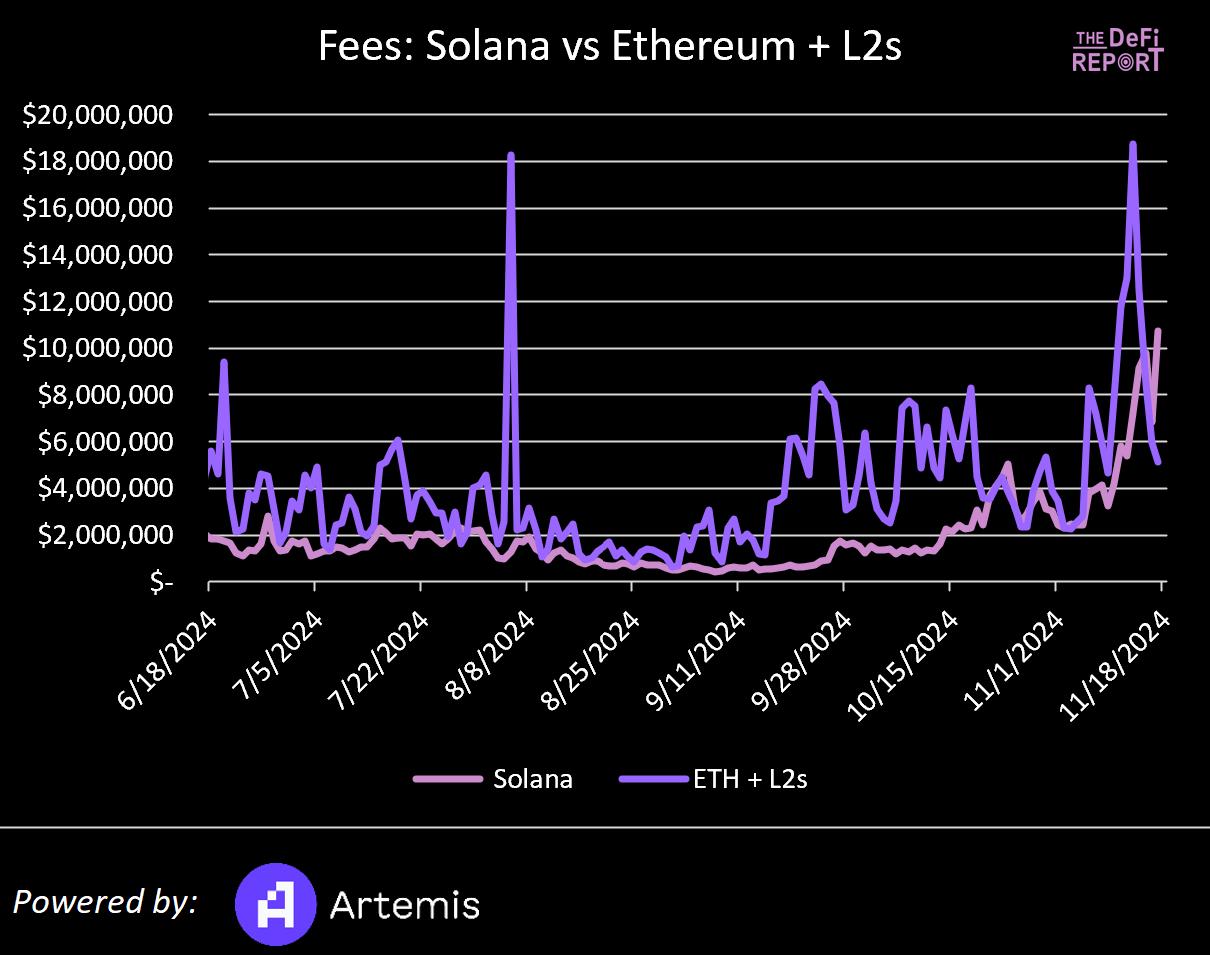
In Q2 2024, Solana's fee revenue was $151 million, accounting for approximately 27% of the total fee revenue of Ethereum and top L2s.
In the past 90 days, Solana's fee revenue reached $192 million, approximately 49% of the total fee revenue of Ethereum ($374 million) and top L2s ($21 million).
Please note that the above fees only include gas fees and do not account for MEV (Maximum Extractable Value) fees.
DEX Trading Volume
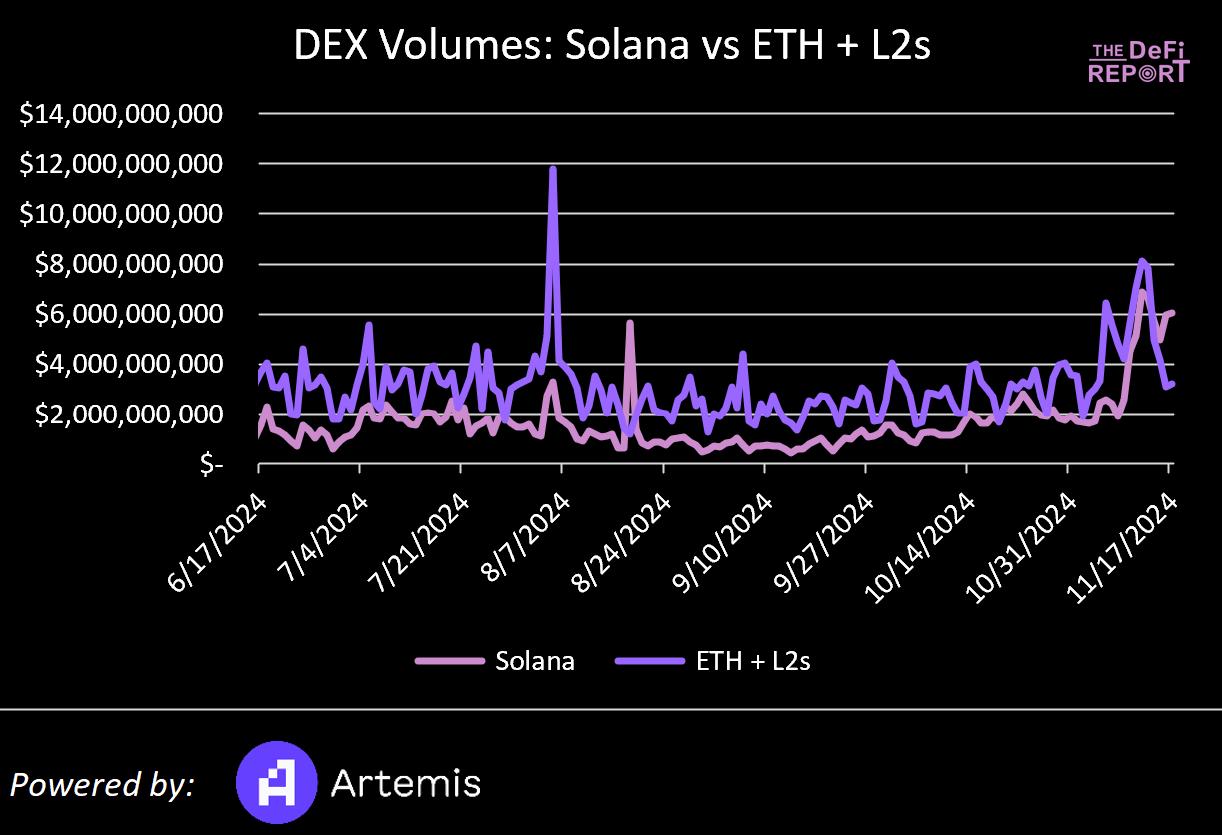
Solana's DEX trading volume in Q2 reached $108 billion, accounting for approximately 36% of the trading volume of Ethereum and top L2s.
In the past 90 days, Solana's DEX trading volume increased to $153 billion, approximately 57% of the trading volume of Ethereum ($125.5 billion) and top L2s ($145 billion).
Stablecoin Supply
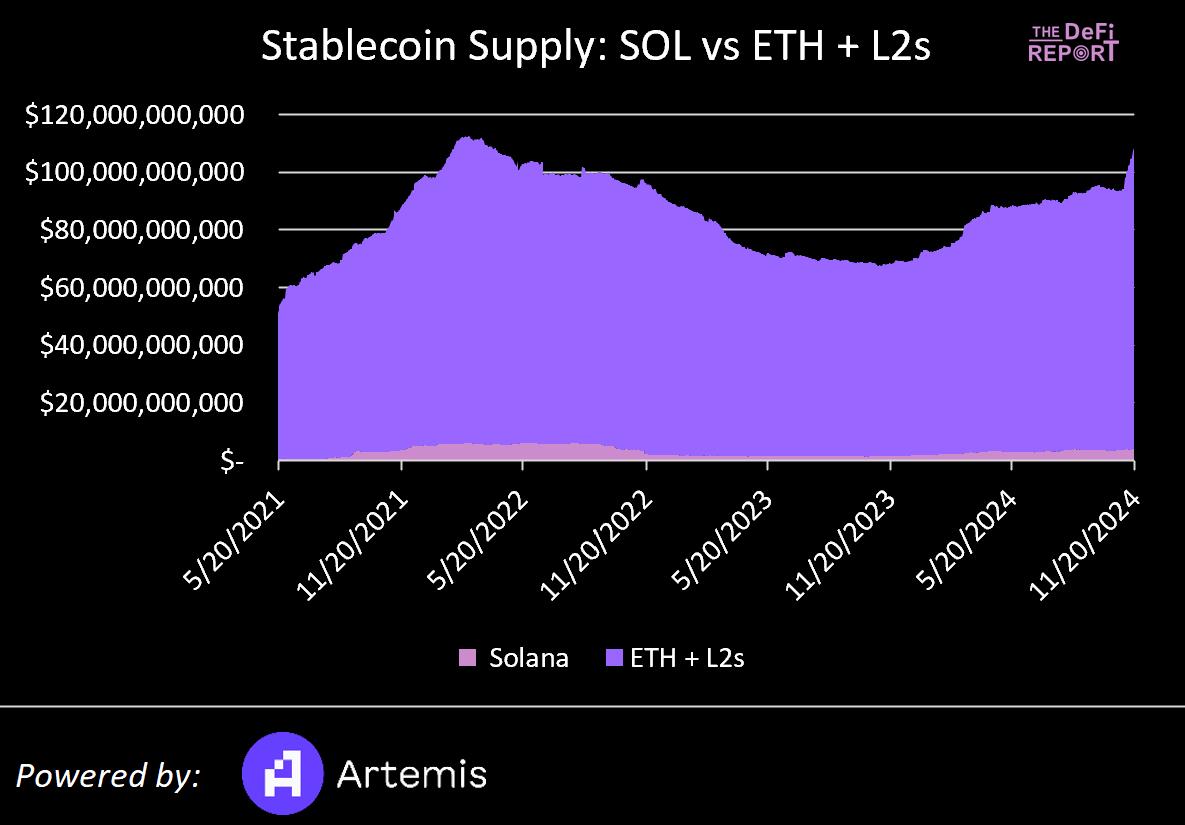
In July 2024, Solana's stablecoin supply was approximately $3.1 billion, accounting for about 3.5% of the stablecoin supply of Ethereum and L2s.
Currently, its stablecoin supply has reached $4.3 billion, accounting for about 4.1% of the stablecoin supply of Ethereum + L2s.
Please note that Arbitrum's stablecoin supply exceeds that of Solana, while Base's stablecoin supply has reached 80% of Solana's.
Stablecoin Trading Volume
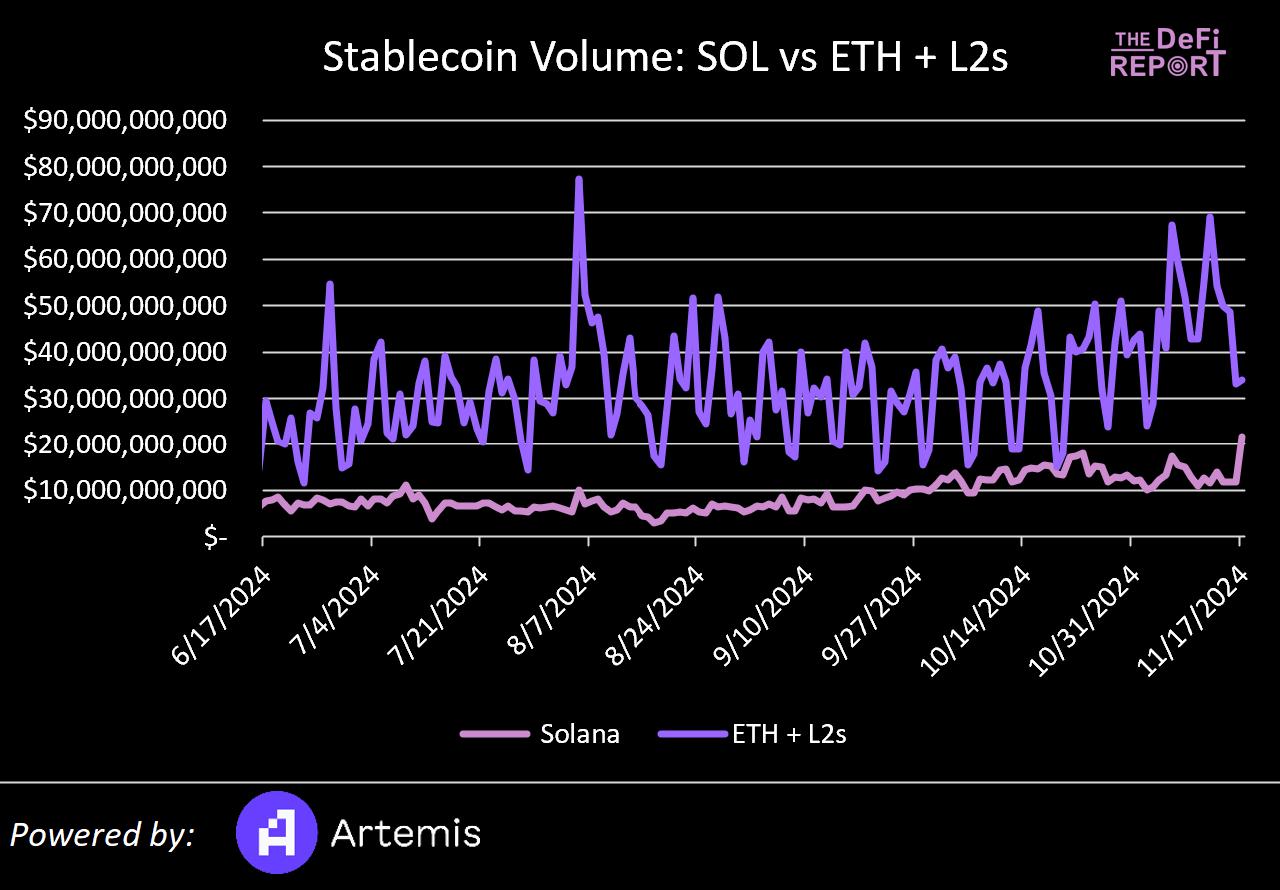
Solana's stablecoin trading volume in Q2 reached $4.7 trillion, 1.9 times that of Ethereum and top L2s.
However, in the past 90 days, Solana's stablecoin trading volume has dropped to $963 billion—about 30% of Ethereum ($1.9 trillion) and top L2s ($1.26 trillion) trading volume.
Why has Solana's trading volume decreased?
We believe that the growth in Solana's trading volume in Q2 was primarily driven by wash trading and algorithmic trading.
According to data from Artemis, only about 6% of Solana's stablecoin trading volume is peer-to-peer transfers. In contrast, this figure is close to 30% on Ethereum L1, indicating that Ethereum is used for non-speculative activities to a much greater extent than Solana.
TVL

At the end of Q2, Solana's TVL was $4.2 billion, accounting for about 6.3% of Ethereum ($60.3 billion) and top L2s ($9.5 billion) TVL.
Currently, Solana's TVL has risen to $8.2 billion, accounting for 12% of Ethereum and top L2s TVL.
Capital Flow
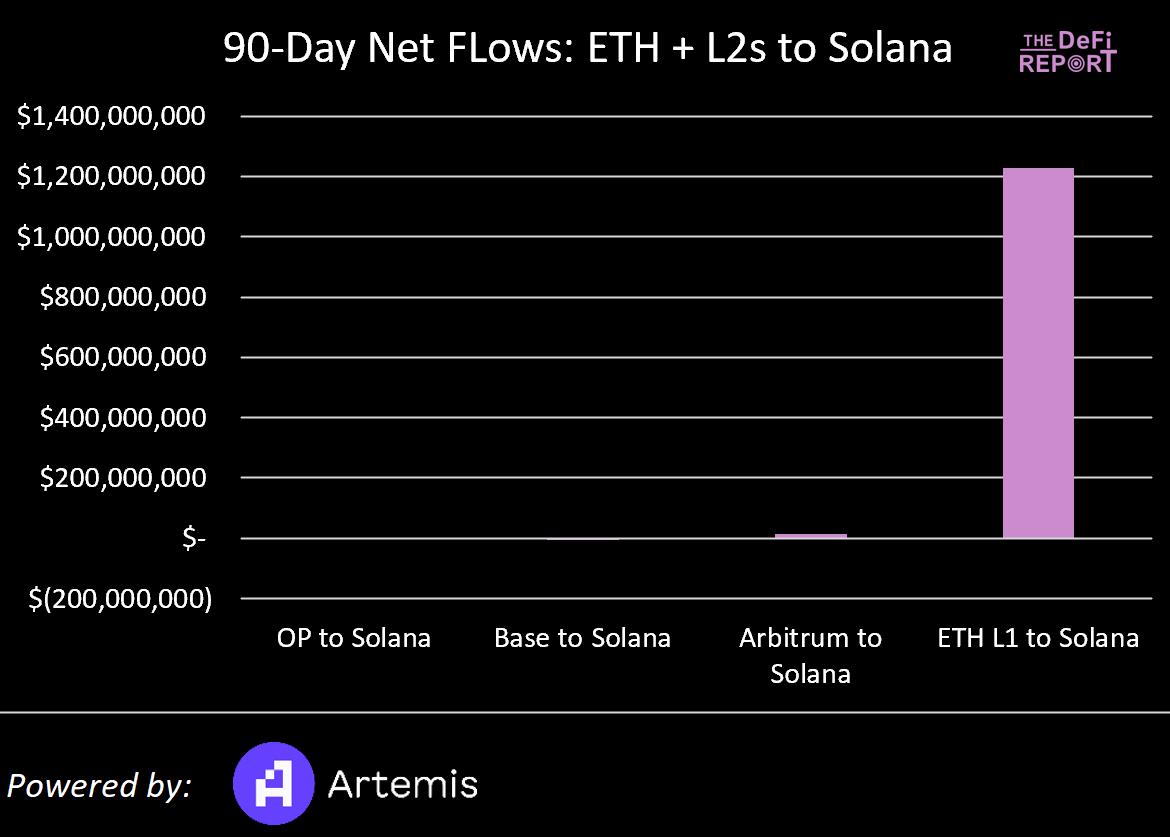
In the past 90 days, Solana attracted over $1.2 billion in TVL from Ethereum, accounting for about 2% of Ethereum L1 TVL. During the same period, it attracted $14 million in TVL from Arbitrum.
At the same time, Solana also lost some TVL to OP ($540,000) and Base ($5 million).
Based on the performance over the past 90 days, the summary of Solana's data is as follows:
Accounts for 49% of Ethereum's fee revenue (up from 27% at the end of Q2).
Accounts for 57% of Ethereum's DEX trading volume (up from 36% at the end of Q2).
Accounts for 4.1% of Ethereum's stablecoin supply (up from 3.5% in Q2).
Accounts for 30% of Ethereum's stablecoin trading volume (down from 190% at the end of Q2).
Accounts for 12% of Ethereum's TVL (up from 6% at the end of Q2).
Solana attracted slightly less than 2% of TVL from Ethereum.
Once again, it is emphasized that the current market pricing of SOL has risen to 70% of Ethereum's market cap. We will delve into the reasonableness of this valuation later. Before that, let’s conduct some more qualitative analysis.
Market Sentiment, Cognition, and Narrative
In the cryptocurrency space, price movements often lead cognition, narrative, and fundamentals. Therefore, considering the price trends of SOL and ETH, the current narrative may lead you to believe that Solana is about to surpass Ethereum.
However, the reality is that Solana currently primarily exists as a Memecoin casino. Of course, there are real projects on Solana, such as Helium and Hivemapper, but the current price trends (and fundamentals) are largely driven by this casino. From what I hear, this phenomenon is quietly influencing Wall Street's perception of this blockchain.
Thus, although the current market narrative is somewhat favorable to Solana, we should anticipate that this trend may change soon. If Ethereum rebounds in 2025, the market narrative could quickly shift from "Ethereum is dead" to "Ethereum is the future of finance."
At the same time, Solana's acceptance of the Memecoin casino may also negatively impact its overall perception and narrative.
Catalysts
Ethereum
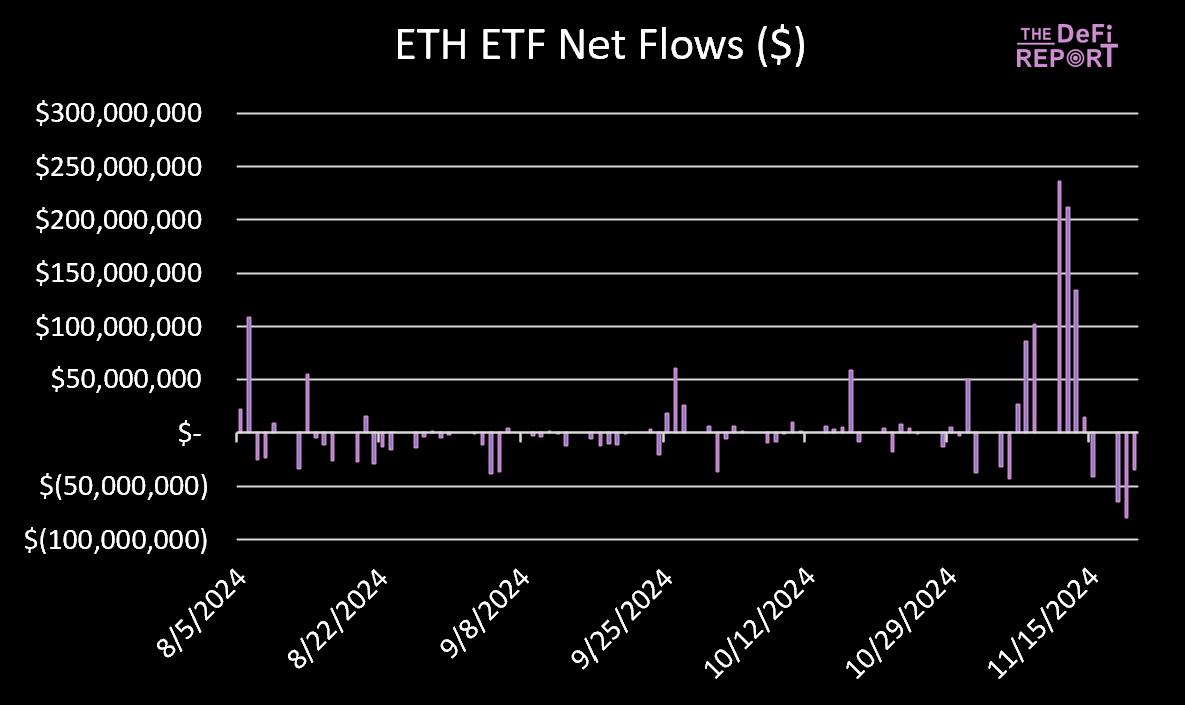
Exchange-Traded Funds (ETFs)
Ethereum spot ETFs have recently begun to see some capital inflows, although the inflow amount is only a small fraction compared to Bitcoin spot ETFs. As of November 20, the net inflow for Ethereum spot ETFs was $469 million, only 1.7% of the net inflow for Bitcoin spot ETFs, far below our initial expectation of a 10-20% capital capture ratio.
So far, this reality has deviated significantly from our predictions, but this gap will not last long. We still believe that as the market cycle progresses, capital will shift towards Ethereum.
DeFi and Real World Assets (RWA)
As the global regulatory environment becomes clearer, we will focus on whether the narrative around DeFi and RWA will heat up. If this happens, we may see companies like Blackrock pushing for more funds to be tokenized on-chain.
There are three reasons for this speculation: 1. They want to tokenize existing funds to improve the efficiency brought by blockchain for backend accounting and management; 2. They aim to capture fees associated with the transformation of traditional financial services companies; 3. Blackrock has sufficient motivation to bring more utility to Ethereum, positioning it as a new financial infrastructure, thereby paving the way for the legitimization of Blackrock's ETF products.
Once more funds begin to tokenize, we may see new use cases emerging in "Permissioned DeFi" to serve asset trading.
In fact, if Ethereum can demonstrate positive price trends now, a new narrative of it being the "chain of Wall Street" may emerge.
Coinbase and Base
In the Ethereum L2 space, Base has stood out as the fastest-growing L2 due to its rapid growth in fees, active users, and stablecoin trading volume. Considering the profit value Base has brought to Coinbase (approximately $68 million year-to-date), we believe it may have created a blueprint for other financial services companies to launch L2s on Ethereum.
Imagine what would happen if giants like JPMorgan, Blackrock, Fidelity, or Robinhood announced the launch of Ethereum L2s?
Clearly, this would further reinforce Ethereum's potential narrative as the "chain of Wall Street."
Solana
Memecoin Frenzy
Phantom recently surpassed Google on Apple's App Store, becoming the number one free utility app.

This is undoubtedly a clear signal that Solana is attracting a large number of new users into the cryptocurrency space. At the same time, it is also a sign of an overheated market.
The next question is: how much more room for growth does the market have?
Retail investors have indeed entered the market, although the scale is smaller than in the previous cycle. One way to measure this phenomenon is to look at the view counts of popular cryptocurrency YouTube channels. From the chart below, we can see that current market activity is still about 50% lower than the peak of the previous cycle.
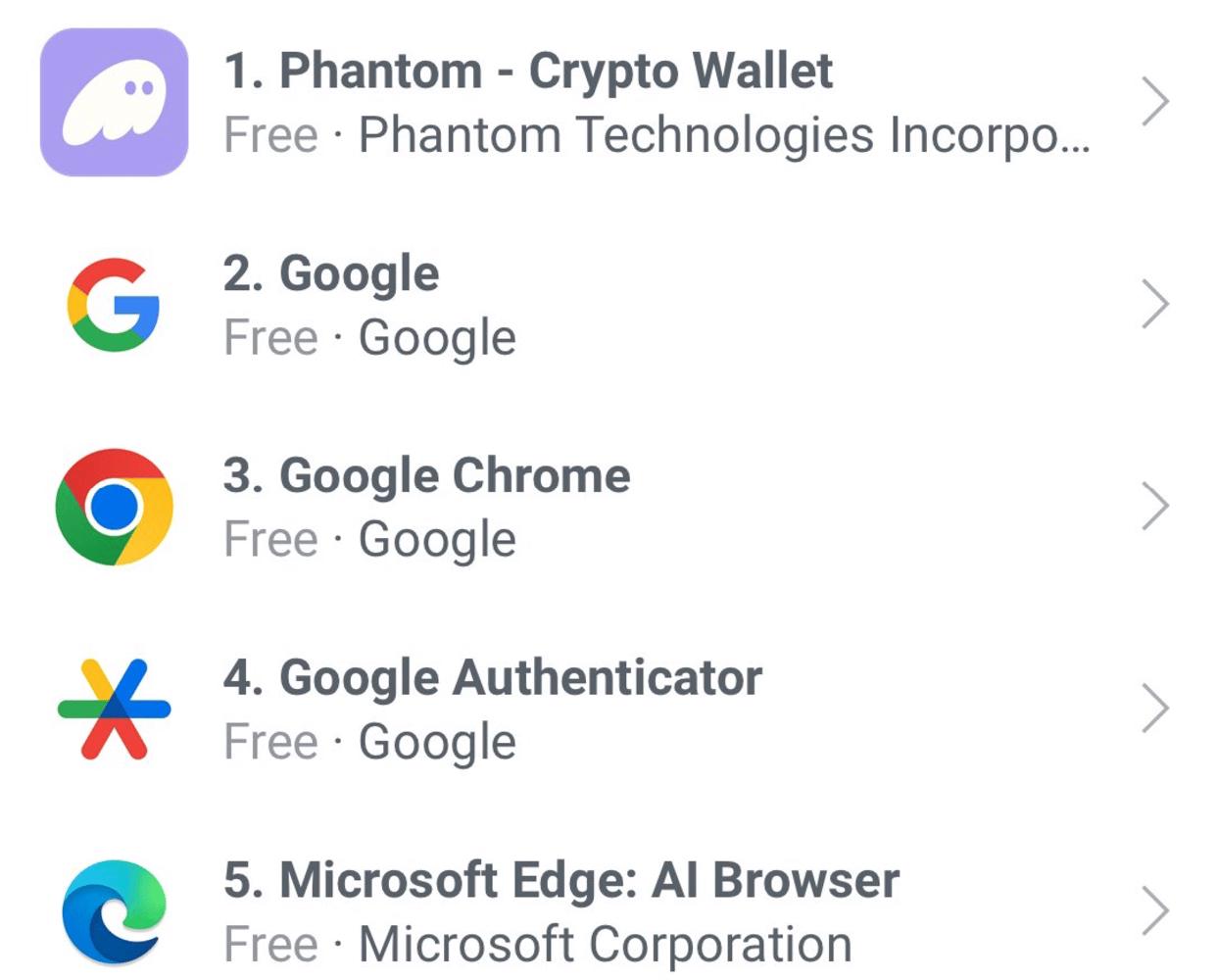
Data: From Benjamin Cowen
While we tend to believe that this number will rise to an extreme level after Bitcoin reaches $100,000, we remain cautious in the short term.
SOL ETF?
Regarding the SOL ETF, the Chicago Board Options Exchange (Cboe) has submitted applications for four Solana spot ETFs to the U.S. Securities and Exchange Commission (SEC), with issuers including VanEck, 21 Shares, Canary Capital, and Bitwise. Given the upcoming personnel changes at the SEC, we expect to see SOL spot ETFs as early as next year. However, unlike Bitcoin and Ethereum, SOL has not yet established a regulated futures market in the U.S.—a key criterion emphasized by the SEC when approving Bitcoin and Ethereum ETFs.
Therefore, the issue with this narrative is whether positive headlines will turn into a "buy the rumor, sell the news" event, as we have seen so far with Ethereum ETFs. (Techub News Note: "Buy the rumor, sell the news" refers to a trading strategy in financial markets (including forex and cryptocurrency markets) where investors trade based on unverified information or rumors and sell to profit once this information is confirmed.)
Firedancer
Firedancer is crucial for the future development of Solana.
Firedancer is a new Solana validator client developed by the cryptocurrency company Jump Crypto. It promises to significantly enhance Solana's performance, reliability, and scalability by supporting more concurrent transactions. It will also improve overall network efficiency and reduce operational costs for node operators.
Most importantly, the introduction of Firedancer will eliminate the current single point of failure (SPOF) in Solana and reduce the likelihood of the chain being halted in the future. (Techub News Note: A single point of failure refers to a problem where the failure of one point in a system can cause the entire system to stop functioning. Solana employs a unique consensus mechanism that combines Proof of History (PoH) and Proof of Stake (PoS), designed to enhance system performance and reliability, but it may also introduce the risk of a single point of failure.)
Firedancer is expected to be ready for mainnet deployment in 2025. While we believe it will greatly benefit Solana's future, it may not be a significant price catalyst in this cycle.
Decentralized Physical Infrastructure Networks (DePIN)
As for the narrative around Decentralized Physical Infrastructure Networks (DePIN), it has not really taken off yet. The decentralized wireless network Helium has risen 147% year-to-date but is still 43% lower than its cycle peak; the decentralized mapping network Hivemapper has increased 164% but is 80% lower than its cycle peak. Compared to July, our confidence in the DePIN space has weakened. At the same time, we have noticed that Memecoins (and to some extent Bitcoin) are siphoning attention and liquidity away from other areas in the market.
Social Media
In July, I wrote that a social media application integrating cryptocurrency in some way was expected to enter the mainstream through celebrities and influencers. While this could still happen, currently this "attention economy" is being expressed through Memecoins. In the short term, it is difficult to see a shift in this situation.
Conclusion
Should SOL's market cap be 70% lower than ETH?
Given the following circumstances:
SOL/ETH reached an all-time high
Over the past few years, the market has adjusted SOL's pricing relative to ETH by 10 times
Since the low point in December 2022, SOL has risen 25 times, while ETH has only risen 1.7 times
Solana's on-chain fundamentals are largely attributed to Memecoin trading
We tend to believe that SOL's relative valuation is reasonable. But the key question is whether SOL can continue to perform well, or even surpass Ethereum?
In our July report, we anticipated that Ethereum ETFs would outperform SOL after their launch and believed that SOL's market cap would peak at around 25% of Ethereum's market cap in this cycle. However, it turns out we were off in both predictions: because the performance of Ethereum ETFs is closer to a "sell the news" event (but so far, we still firmly believe that demand will come), while SOL has continued to rise alongside Bitcoin.
Currently, Bitcoin has seen a significant increase over the past few weeks. We expect some volatility and pullbacks before the end of the year, but overall, the market still has upward potential in 2025.
Historical data shows that in the last cycle, Bitcoin reached an all-time high in Q4 2020, while Ethereum peaked in early February 2021, achieving a 5.4 times increase in the first four months of that year.
Once again, it is emphasized that prices lead in the cryptocurrency space, and market narratives follow prices.
The market may experience a similar trend in this cycle. If so, we may see a positive shift in sentiment and narrative around Ethereum in 2025.
Meanwhile, Solana, as the "retail casino/Memecoin chain," may face some challenges.
Of course, there is also the opposing view that "things that perform well early in the cryptocurrency cycle often continue to show strong momentum later"—which also provides strong support for SOL's continued rise.
In summary, we believe the market has largely reassessed SOL's valuation relative to ETH, and the current fundamentals align roughly with this relative valuation. However, future trends remain uncertain, and what happens next remains to be seen.
免责声明:本文章仅代表作者个人观点,不代表本平台的立场和观点。本文章仅供信息分享,不构成对任何人的任何投资建议。用户与作者之间的任何争议,与本平台无关。如网页中刊载的文章或图片涉及侵权,请提供相关的权利证明和身份证明发送邮件到support@aicoin.com,本平台相关工作人员将会进行核查。




